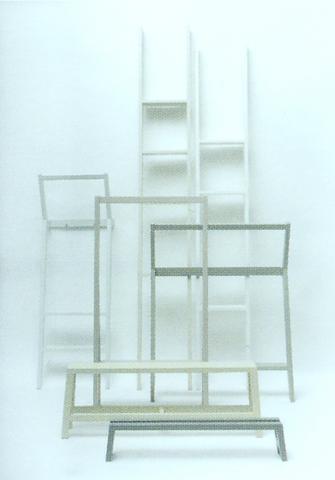Amorphous chairs, outrageously colored lamps and many other contemporary designs have gradually moved into "hip" households in Taiwan. As Germany and Scandinavian countries are still most often associated with contemporary design in people's minds here, the current exhibition at Taipei Fine Arts Museum (
Domains -- Contemporary Israeli Design (領域: 當代以色列設計展) is a traveling exhibition aimed at audience in East Asia and the Pacific region. To present a rounded sampling of contemporary Israeli design, well-known designers are exhibiting, such as Yaacov Kaufman -- who works for Lumina Italia -- as well as rising talents such as Ron Gilad, whose bullet-shot vase caught much attention at the opening of the show. Most of the 10 designers have gained increasing international recognition for their innovative works with a unique identity.

PHOTO COURTESY OF TFAM
Nirith Nelson, curator of Domains, explains at the opening of the exhibition that the short history of the state of Israel encourages designers to try out innovative concepts while the diversity of ethnic groups contributes to the variety of design approaches. The unstable political situation and limited economy in Israel, Nelson said, has turned designers' attention to improvisation and quick-fixes instead of time-consuming complex devices.
These improvisations are usually very amusing and original. Some of them have a pristine kind of beauty.
Yaacov Kaufman had in mind humanity's first chair when he designed Potchim. This one-off piece uses a complete block of tree trunk, part of which is still covered with bark. By making only two cuts and fixing a pair of hinges on the trunk, it becomes a folding chair. A similar trunk is cut only once, in a long "s" curve, to become a pair of chairs which easily blend in with a forest.
A recent graduate from Israel's well-known Bezalel Academy of Art and Design, Sharon Peter Shechter incorporates the element of time in his furniture design in a humourous way. In Lamp Table, a table with book ends, Shechter cuts the veneer of formica from the wood table surface and bends the protruding formica to form the stem of a lamp and book ends. In Israeli households, there are countless tables which share this peeling-veneer appearance, only there it was caused by wear.
Probably the most beautiful work in the exhibition is Ami Drach and Dov Ganchrow's Ga-mish, which looks nothing like a household object. The framed flexible plywood strips forms a vertical fretwork.
Placed against a wall, it can be a shelf of flexible compartments. Standing alone, it can be a room partition, or a floor window suitable for a Mediterranean climate. Whatever it is, the structure is a pleasure to look at. Pleasure, according to the curator Nelson, is one of the main triggers of Israel design today.
Domains -- Contemporary Israeli Design will run through Feb. 15 at Taipei Fine Arts Museum, 181, Zhongshan N Rd, Sec 3, Taipei. (

Exceptions to the rule are sometimes revealing. For a brief few years, there was an emerging ideological split between the Democratic Progressive Party (DPP) and Chinese Nationalist Party (KMT) that appeared to be pushing the DPP in a direction that would be considered more liberal, and the KMT more conservative. In the previous column, “The KMT-DPP’s bureaucrat-led developmental state” (Dec. 11, page 12), we examined how Taiwan’s democratic system developed, and how both the two main parties largely accepted a similar consensus on how Taiwan should be run domestically and did not split along the left-right lines more familiar in

As I finally slid into the warm embrace of the hot, clifftop pool, it was a serene moment of reflection. The sound of the river reflected off the cave walls, the white of our camping lights reflected off the dark, shimmering surface of the water, and I reflected on how fortunate I was to be here. After all, the beautiful walk through narrow canyons that had brought us here had been inaccessible for five years — and will be again soon. The day had started at the Huisun Forest Area (惠蓀林場), at the end of Nantou County Route 80, north and east

Specialty sandwiches loaded with the contents of an entire charcuterie board, overflowing with sauces, creams and all manner of creative add-ons, is perhaps one of the biggest global food trends of this year. From London to New York, lines form down the block for mortadella, burrata, pistachio and more stuffed between slices of fresh sourdough, rye or focaccia. To try the trend in Taipei, Munchies Mafia is for sure the spot — could this be the best sandwich in town? Carlos from Spain and Sergio from Mexico opened this spot just seven months ago. The two met working in the

This month the government ordered a one-year block of Xiaohongshu (小紅書) or Rednote, a Chinese social media platform with more than 3 million users in Taiwan. The government pointed to widespread fraud activity on the platform, along with cybersecurity failures. Officials said that they had reached out to the company and asked it to change. However, they received no response. The pro-China parties, the Chinese Nationalist Party (KMT) and Taiwan People’s Party (TPP), immediately swung into action, denouncing the ban as an attack on free speech. This “free speech” claim was then echoed by the People’s Republic of China (PRC),